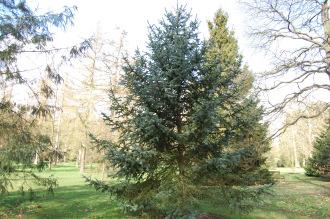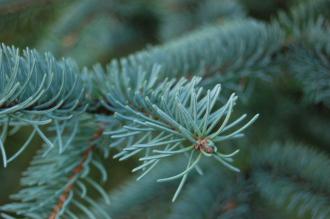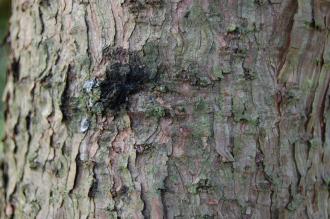
Picea koraiensis (01/03/2015, Kew Gardens, London)
Position: Full sun to partial shade
Flowering period: Late spring
Soil: Moist, well drained
Eventual Height: 30m
Eventual Spread: 12m
Hardiness: 5a, 5b, 6a, 6b, 7a, 7b, 8a, 8b
Family: Pinaceae
Picea koraiensis is a large coniferous evergreen tree with a conical habit. Its grey/ green leaves are needle like, up to 22mm long and 1.8mm across. Its trunk may achieve a diameter of up to 80cm. Its gray to red/ brown bark is flaking. Its male flowers are in the form of pollen cones. Its female fruit are ovoid to cylindrical cones, maturing to pale brown, up to 8cm long and 3.5cm across.

Picea koraiensis Leaf (01/03/2015, Kew Gardens, London)
Picea koraiensis, commonly known as Korean Spruce, is native to north Korea, north east China and south east Russia. In its native habitat it grows in coniferous woodland on mountain slopes in coniferous forests at an altitude of 400m to 1800m.
The etymological root of the binomial name Picea is derived from the Latin Pix meaning ‘pitch or tar’ in reference to the Spruce trees resin. Koraiensis is derived form the Latin meaning ‘from Korea’.

Picea koraiensis Bark (01/03/2015, Kew Gardens, London)
When available the landscape architect may find Picea koraiensis useful as an attractive coniferous specimen tree.
Ecologically, Picea koraiensis seeds are attractive to some birds.
Picea koraiensis prefers moist, humus rich, well-drained soils. It tolerates most pH of soil.
Picea koraiensis requires little maintenance.

